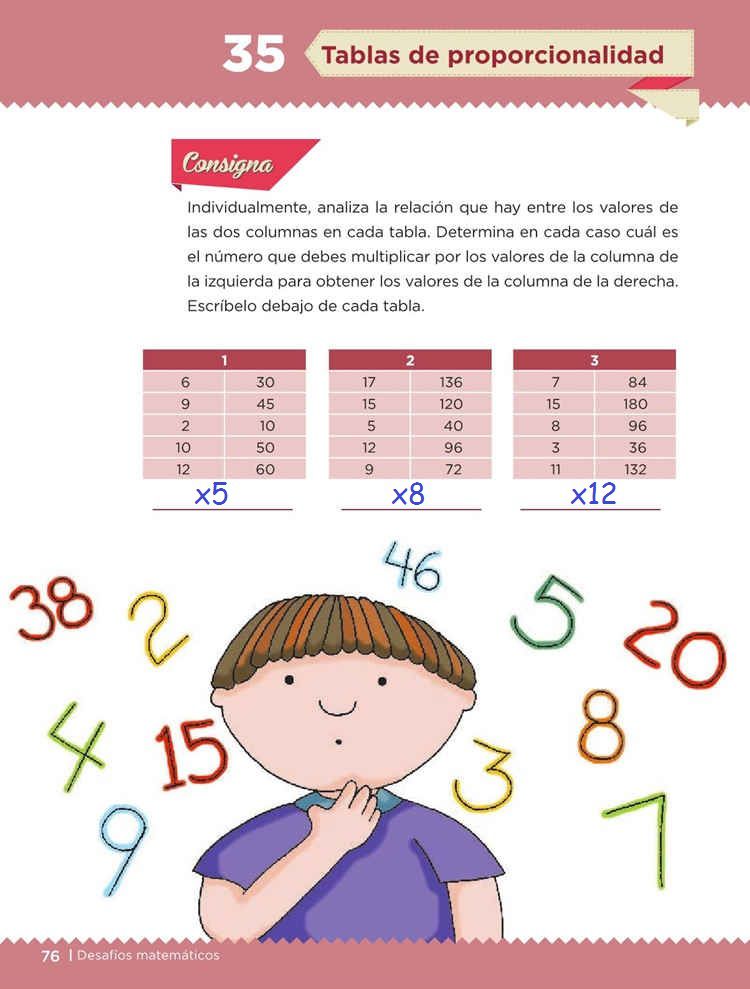ADS
Tablas de proporcionalidad
bloque-iiDesafío 35Libro Desafíos Matemáticos Quinto grado Contestado
Ciclo Escolar: 2014|2015|2016|2017
Instrucciones
Objetivo de la lección:
- Que los alumnos identifiquen el factor constante de proporcionalidad en una tabla con dos conjuntos de valores que son proporcionales.
Consigna: La instrucción de la consigna te indica en principio que "debes multiplicar" los valores de la columna izquierda por un un numero que debes identificar para obtener los resultados de la columna derecha. En cada columna hay un valor que es fácil calcular mentalmente por ejemplo 9x5=45, a partir de ese dato podemos comprobarlo con 2x5=10, y 10x5=50, por lo tanto el factor constante de proporcionalidad es multiplicar por 5.
Lo mismo hacemos con la siguiente columna 5x8 es fácil calcular mentalmente que el resultado es 40, y si multiplicamos cualquier otro numero de la columna izquierda x8 nos damos cuenta que efectivamente el factor constante de proporcionalidad es multiplicar por 8.
En la tercera columna el numero fácil de calcular mentalmente es 3x12=36 al multiplicar otro numero por 12 comprobamos que el factor constante de proporcionalidad es multiplicar por 12.
Al identificar el factor constante podemos afirmar que cada tabla representa una relación de proporcionalidad entre dos conjuros de valores.
Tu maestro espera que no haya dificultad para resolver este desafío, pero recuerda que siempre puedes realizar preguntas si tuviste alguna duda y si crees que hay algún cambio que se pueda hacer para mejorar la consigna hazlo saber a tu maestro.
Cambien recuerda dejar tus dudas y comentarios en la sección de correspondiente (más abajo).


Abogado de Accidentes de Semi Camiones
ResponderEliminarThe text provides a comprehensive review of the "Tables of Proportionality - Challenge 35 - Mathematical Challenges for Fifth Grade Answers" which offers clear and concise answers to mathematical challenges for fifth-grade students. The answers are accurate, step-by-step, and visually appealing, making them easy for young learners to understand. They also encourage students to explore alternative approaches to solving proportionality problems, fostering critical thinking. The text also highlights common mistakes that students might make in these types of problems and how to avoid them. It also highlights the visual appeal of the document, such as colors and illustrations. The worksheet format is also important, with clear and sequential questions. The text also discusses the importance of practical applications, vocabulary building, and challenge problems for advanced learners. It also mentions the potential for incorporating real-life examples and scenarios to make the learning experience more relatable. A practice test with varying difficulty levels is suggested to assess students' comprehension. The content is aligned with fifth-grade mathematical standards and curriculum, and it can be used as homework assistance or a tool for parents to assist their children with math homework. The answers can also be turned into an interactive online resource with self-checking quizzes. Accessibility is another key consideration, with the document or resource being accessible to all students, including those with special needs. Peer review is also suggested for additional insights and perspectives. The text also emphasizes the need for engagement strategies, recognizing multiple learning styles, and encouraging exploration. It also emphasizes future updates based on user feedback and changing educational needs. Overall, the answers provide a strong foundation for teaching proportionality to fifth-grade students, but there is room for improvement and addressing different learning styles.